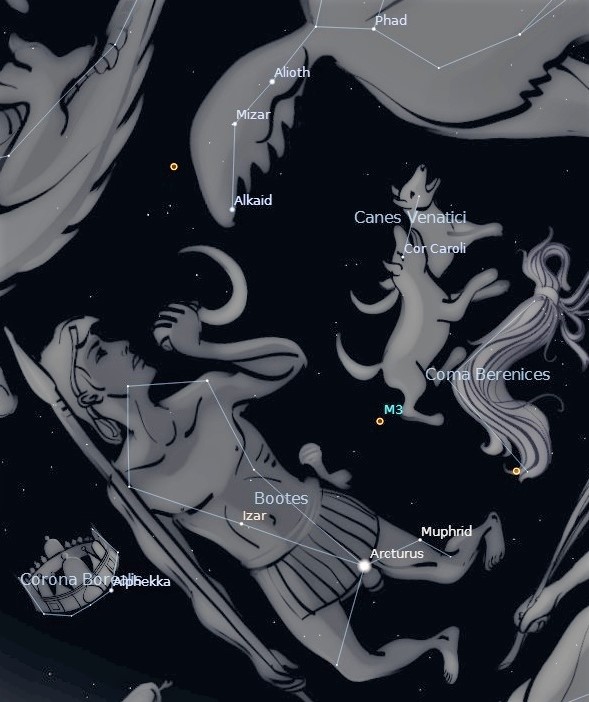This Week’s Sky at a Glance, 2023 March 25 – April 1~

This Week’s Sky at a Glance, 2023 March 25 – April 1~
Arcturus anchors the constellation Boötes (bo-oh-teez) the Herdsman, and the star’s name means “bear driver.” Boötes is seen chasing the two bears, Ursa Major and Ursa Minor, around the celestial North Pole. To many people the constellation resembles a tie, a kite or an ice cream cone. The head of the herdsman, at the tip of the constellation opposite Arcturus, is the star Nekkar, which sounds somewhat like necktie.
Halfway between Arcturus and the hind leg of Ursa Major is the star Cor Coroli in Canes Venatici the Hunting Dogs. Use binoculars to look for a fuzzy patch halfway between Arcturus and Cor Coroli. This is a globular cluster called M3, the third entry in Charles Messier’s 18th century catalogue of things that resemble a comet but aren’t. This cluster contains half a million stars at a distance of 34,000 light years, nearly a thousand times farther than Arcturus.
This Week in the Solar System
Saturday’s sunrise in Moncton is at 7:13 am and sunset will occur at 7:38 pm, giving 12 hours, 25 minutes of daylight (7:18 am and 7:42 pm in Saint John). Next Saturday the Sun will rise at 6:59 am and set at 7:47 pm, giving 12 hours, 48 minutes of daylight (7:05 am and 7:51 pm in Saint John).
The Moon is near Mars on Tuesday and at first quarter phase on Wednesday. For Earth Hour this Saturday turn off your lights and have a look at the Moon passing near the Pleiades star cluster. On Monday Mercury can be found just to the right of Jupiter, setting between 8:30 and 8:40 pm. Venus garners most of the evening attention, and on Friday it sits two degrees above Uranus. Over Wednesday and Thursday evenings Mars makes a scenic binocular pairing with the M35 star in Gemini. Saturn rises an hour before the Sun this weekend, and lengthens that gap by 15 minutes over the week.
Questions? Contact Curt Nason
